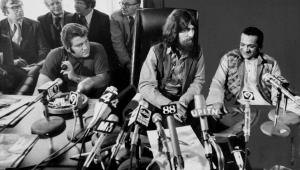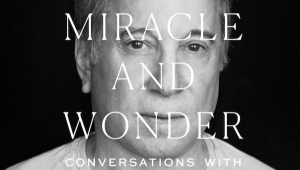Dylan Then & Dylan Now. Forty Years Is A Long, Long Time...Or Is It, Really? (Part 1)

The famous motorcycle accident in 1966 that disabled a rising music starthen mired in a now long-forgotten controversy of folk-versus-popsetting the stage for an extended period of seclusion and retreat. It’s an episode that continues to intrigue tellers of the star’s story (a recent article in American Heritage magazine, for example, can’t help introducing it as “The Bob Dylan Motorcycle-Crash Mystery”).
And for many chroniclers, it remains the central event in the Legend of Bob Dylan, the before-and-after moment, the durable frame for the-young-and-the-old, the-rise-and-the-fall, the Icarus-inflected storyline of the-burning-meteor-and-the-fallen-angel cautionary tale.
That tragic locking of brakes on Dylan’s 500cc Triumph (if that’s what really happened) capped the lurid narrative of 2001’s “Positively 4th Street” by David Hajdu (a sensationalized, tabloid rendering of Dylan’s romance with Joan Baez, told in parallel with the late mystic poet and musical explorer Richard Fariña’s wooing, and marrying, of Joan’s late little sister, Mimi).
And it provided the spring-drive for last year’s riveting Martin Scorsese-produced PBS documentary, “No Direction Home,” which follows Dylan from Minnesota to New York, and from New York to England and to the crash.
But is it really as central an event as it’s made out to be?
According to that version of the myth, Dylan is the tortured young poet “Situations have ended sad, relationships have all been bad; mine have been like Verlaine’s and Rimbaud’s ...” who reaches a fiery crescendo of creative inspiration, trades his Martin acoustic for a solid-body Stratocaster, turns his back on the prohibitions of the Left-leaning folk movement, plugs in, and … rocks it.
And according to that telling, Bringing It All Back Home, Highway 61 Revisited, and Blonde on Blonde remain the Holy Trinity, the absolute height of rock rebellion -- all snarls and whiplash guitar, biting wit and supersonic blues. “I see you got your ... brand new leopard-skin hat ... don’t you .... Mr. JONES?” (Cue Al Kooper’s B-3, doom-impending organ swirls ...)
In that scenario, Dylan falls from great heights and, stumbling to right himself, throws off a series of not-entirely-decipherable albums, a run characterized by the weirdest attempt at singing “sweet,” with pedal-steel country-style reveries, andcan you believe it?out-and-out LOVE songs. (Not to mention a duet with Johnny Cash, who, at the time, was anything but a counterculture figure.)
When they came out, John Wesley Harding, Nashville Skyline, Self Portrait, and New Morning, seemed well-intended enough, but definitely weak -- the fiery Dylan now overshadowed by Gram Parsons’ Byrds, the stadium-overflowing Stones, and, very soon, the commercialized country rock of Jackson Browne, Linda Ronstadt, and The Eagles, et. al.
Follow that plot line and what you have is Dylan regaining his footing briefly, mainly through his collaboration with The Band and the gallivanting Gypsy-rock of the Rolling Thunder Revue -- with The Basement Tapes, Blood on the Tracks, Desire, and Street Legal tossed off along the way, as random, gem-like masterpiecesuntil he descends once gain into “madness” with the Born-Again streak of Slow Train Coming, Saved, Shot of Love, and Infidels.
All of which leads to the late-1980s creative dead-end described in “Chronicles, Volume One” (and symbolized, cleverly enough, by Dylan & the Dead). And what follows that death and rebirth is the post-modern, post-industrial resurrection outlined by the recent trilogy, Time Out of Mind (1997), ““Love and Theft”” (2001), and Modern Times, released in August of 2006.
From one creative peak to anotherBlonde on Blonde to Modern Times it’s been 40 years, almost to the day. And in both instances, the deeply resonant death-and-rebirth plotline, resident in worldwide myth figures prominently, provides a handy template for storytelling, which Scorsese’s “No Direction Home” employswith Dylan as an old man narrating the adventures of his youthto maximum effect.
It’s a neat narrative overview, one that will serve to quickly inform the uninformedand market the marketing peoplequite nicely. But, as they’re so fond of observing in the halls of academe, it’s the canonical view, and for all the power it retains as a “Cliff’s Notes” version of a life’s work, it leaves out far too many of the actual facts and fails to tell the whole story.
To shift perspective for a moment, let’s consider two pieces of unlikely evidence. The first is what we might think of as the actual historical record ... or rather, the records. That is, the recordings Dylan has actually made.
One fault of myth-making is the distortion created by drawing a line only through selected plot points. And in Dylan’s case, what’s most often left out is the beginning, the four albums in his discography that preceded the folk/pop schism and the fiery pinnacle before the crash: Bob Dylan, The Freewheelin’ Bob Dylan, The Times They Are A’Changin’, and Another Side of Bob Dylan, the last of which has the Maestro of Mystery banging on neither acoustic or electric guitars, but a keyboard, just as he does now in concert.
The other piece of evidence I’d like to consider is a CD also released in August that likely will sell very few copies and win very little critical attention (not because it’s a bad recording, or because it doesn’t lay out ambitions and achieve them, but because it doesn’t fall into any of the neat contemporary categories for commercial promotion or critical consideration): Maria Muldaur’s Heart of Mine: The Love Songs of Bob Dylan (on Telarc).
As Muldaur herself readily admits in the liner notes to Heart of Mine, an entire album of Dylan love songs might seem like a far-fetched project. Until you actually listen to the songs. The same thing happened, she recalls, when she first heard Dylan’s topical numbers: “I wasn’t attracted to the rather tuneless, polarizing diatribes that characterized the protest music of the day,” she says, “ but it wasn’t long before I began to realize Bob’s songs were different. Very different.”
But certainly, he shouldn’t be considered on a par with the likes of George Gershwin or Cole Porter, not Lennon & McCartney or even Burt Bacharach. And as writer of love songs? Bob Dylan? Aren’t those mostly just filler for his more meaningful social proclamations? Stocking stuffers compared to the sort of magnum opus, something on the order of “Like a Rolling Stone,” that an eminent critical mind like, say, Greil Marcus’, might devote an entire book to?
“He will probably be remembered more as a celebrity who influenced American politics and ideology than as a songwriter,” insists ragtime pianist and music connoisseur Max Morath, stating what is probably -- setting aside the vast contingent of Dylan lovers -- more of a mainstream view. “Singers and musicians, especially in jazz, seek compositions that challenge their own creativity, material that invites invention not reiteration,” Morath continues. “Dylan’s songs have largely been ignored, except by rock groups or folk singers....”
Too bad about those clueless rockers and folkies. Too bad, too, about Cassandra Wilson and Abbey Lincoln, both of whom have taken on Dylan songs (“Lay Lady Lay,” “Shelter from the Storm,” and “Mr. Tambourine Man”) and successfully reset them in jazz-inflected arrangements. Too bad, as well, about Maria Muldaur, who finds Dylan’s “Moonlight” from “Love and Theft”: “ ... [L]ike an evocative, gorgeous, impressionistic painting set to one of the most beautiful chord progressions and melodies I’ve ever heard.”
Setting aside for a moment Morath’s clear class prejudices and his unmistakable air of aesthetic condescension, the central question he raises is probably worth considering: What kind of a songwriter is Bob Dylan? And to make the implicit explicit: How will history remember him and his work?
The prevailing Dylan Myth takes its outline partly from commercial imperativesthe burn-crash-and-resurrection plot line became so familiar to viewers of VH1’s “Behind the Scenes” series that the program simply ran out of new material ... everyone they profiled fit the same pattern. And it’s probably the only view possible from the sales charts: one day you’re on the charts, and the next day you’re not; but somewhere down the road, you’ll be back again.
Step away from that logic, for moment, however, and the Dylan story takes on an entirely different cast.
Look into the motorcycle crash incident, for example, and you’ll find evidence that Dylan was actually engineering a calculated retreat from the pressures of pop fame and commercial success (“I realized I was just workin’ for all these leeches,” he later told an interviewer). Take a closer look at Dylan the songwriter and what you’ll find, I think, is a remarkably consistent craftsman forging vernacular lyrics clearly inspired by the work of Romantic and surrealistic poets.
Consider the matter of love songs. Of the fourteen songs that make up Blonde on Blonde, eleven are love songs of one type or another. And the last, “Sad Eyed Lady of the Lowlands,” is a love song of epic proportions, clocking in at 11:20 and in the original release, occupying the entire side of an LP, something never attempted before. Now, toggle back to Modern Timeshalf of its ten tracks easily qualify as love songs of one kind or another.
Then, backtrack to those first four releases and you’ll find some lovely paeans to love, from “Baby, Let Me Follow You Down” and “Girl From the North Country” to “All I Really Want to Do,” “Boots of Spanish Leather,” and even “It Ain’t Me, Babe,” each rendered mainly in the materials Dylan favored at the time: primarily borrowings from the Anglo-Scottish-Appalachian folk tradition.
And, as Heart of Mine… makes indisputably clear, Dylan’s love songs lack for neither power of expression or intriguing material that challenges an accomplished singer’s creativity. “It was a great pleasure and, at times, quite a challenge for me,” Muldaur admits, “to wrap myself around these soulful songs and make them my own.” The results, rendered in spare but evocative settings, live up to every expectation Telarc’s close attention to sonic quality might invite.
It shouldn’t come as a surprise, really, to have Bob Dylan running in a sweepstakes for love-song composerswe’ve already had Gospel and reggae reclamations of his work Gotta Serve Somebody and Is It Rolling, Bob?, respectively). A couple of years ago, Telarc even remade Blonde on Blonde track-for-track with an eclectic array of blues and roots musicians. And 2003’s soundtrack, Masked and Anonymous, gave us Japanese-, Turkish-, and Italian-language versions of Dylan classics every bit as evocative as their English-language counterparts.
And, as if to demonstrate the durability of Dylan compositions, Heart of Mine… also provides us with Muldaur’s second reworking of “Moonlight” the first was on her previous Telarc CD, Love Wants to Dance, a slinky, supper-clubbish outing with Muldaur cast as a swanky jazz chanteuse (where Heart of Mine casts Muldaur more in the role of Sweetheart of the Rodeo).
One major drawback to imposing the narrative of “creative peaks” of the conventional Bob Dylan narrative is that it overlooks the truly enlightening work that occupies what would then be considered “valleys.” In the earliest recordings, for example, we miss both the love songs and the hard-rocking blues that accompany the masterful “protest” songs. The fiery crescendo of Bringing It All Back Home, Highway 61 Revisited, and Blonde on Blonde also obscures the balladeer and romantic lurking just below the surface.
They may not have been written for Tony Bennett, but it’s hard to imagine more-ardent Hallmark-card sentiments than those expressed in the opening lines to “Love Minus Zero/No Limits” from Bringing it All Back Home:
Without ideals or violence,
She doesn’t have to say she’s faithful,
Yet she’s true like ice, like fire.”
What we miss as well is the way those earliest recordings lead quite naturally to the triple-masterpiece period before “the crash.” For all the brouhaha about Dylan “going electric” in 1965, it’s worth remembering that he began recording with electric instruments during the sessions for 1963’s The Freewheelin’ Bob Dylan (why the “freewheelin’,” after all?).
And Another Side of Bob Dylan contains compositions easily as blues-drenched and wildly imaginatively as anything on Blonde on Blonde (like “I Shall Be Free No. 10,” with its topical, sing-song, rhyming couplets that clearly anticipate, in their good-hearted and folkie way, the topical observations and rhyming rhythms of rap).
Also in hindsight, the crooning voice and the hoedown country settings that sounded so off-putting in the series of releases after “the crash” we can now see as clearly anticipating the Texas-swing/rockabilly matinee-idol persona of Dylan’s most-recent creative streak.
In more-recent times, isolating Time Out of Mind, “Love and Theft”, and Modern Times from the music that surrounds them overlooks both the pair of solo acoustic albumsGood As I Been to You and World Gone Wrongthat preceded the recent creative renaissance as well as the lovely Songs of Jimmie Rodgers: A Tribute, a multiple-artists tribute every bit as seminal to its time as the 1990 Folkways: A Vision Shared -- A Tribute to Woody Guthrie and Leadbelly, which appeared at the beginning of a “roots” revival which continues to this day.
A Dylan-sponsored project released in 1997 on his own Egyptian Records/Columbia imprint, Songs of Jimmie Rodgers gives us one of the artist’s most-explicit confessions of creative inspiration, expressed in the music covered and especially in the liner notes penned by Dylan:
“Jimmie Rodgers ... [is] a blazing star whose sound was and remains the raw essence of individuality in a sea of conformity, par excellence with no equal ... His message is all between the lines and he delivers it like nectar that can drill through steel ... No supporting actor in a melodrama or a screw in a machine, not a team player, no old-liner or stick-in-the-mud, he is the ringmaster general and is, as in the Warren Smith ballad, the man who ‘ ... held your hand and sang you a song.’ ... His is the voice in the wilderness of your head. Only in turning up the volume can we determine our own destiny.”
Dylan is clearly talking about his own self-crafted persona in describing a creative temperament that may or may not have been present in Jimmie Rodgers but clearly is present throughout the whole of Dylan’s work, from those first, super-charged folk transformations of his initial Columbia release through the voice-like prose of “Chronicles, Volume One,” as neat a piece of literary sleight-of-hand as any fiction writer might pull of, and every bit as compelling as the voice-over narration of “Catcher in the Rye.”
And while a majority of listeners may react primarily to the musical materials he uses at any given momentpreferring Dylan the folkie to Dylan the rocker, Dylan the insurgent to Dylan the crooner, Dylan the romantic to Dylan the philosopher, blues Dylan to country Dylanrethinking his work from the point-of-view of the artist assigns complementary roles to both the poet and the musician, elevating instead the sensibility behind both the combination of poetry and music.
And for those who doubt that sensibility is fiercely intentional -- carefully calculating every beat, every lick, every costume changethe double-CD release accompanying the “No Direction Home” documentary provides the kind of evidence rarely available for the work of any artist and accessible nowhere else for Mr. Dylan.
- Log in or register to post comments
















































